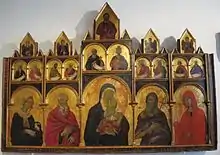Polyptych
A polyptych (/ˈpɒlɪptɪk/ POL-ip-tik; Greek: poly- "many" and ptychē "fold") is a painting (usually panel painting) which is divided into sections, or panels. Specifically, a "diptych" is a two-part work of art; a "triptych" is a three-part work; a tetraptych or quadriptych has four parts, whereas a polyptych describes any work of art formed of more than one constitutive part.


Historically, polyptychs typically displayed one "central" or "main" panel that was usually the largest of the attachments; the other panels are called "side" panels, or "wings". Sometimes, as evident in the Ghent and Isenheim works (see below), the hinged panels can be varied in arrangement to show different "views" or "openings" in the piece. The upper panels often depict static scenes, while the lower register, the predella, often depict small narrative scenes.
Polyptychs were most commonly created by early Renaissance painters, the majority of whom designed their works to be altarpieces in churches and cathedrals. The polyptych form of art was also quite popular among ukiyo-e printmakers of Edo period Japan.
Some medieval manuscripts are polyptychs, particularly Carolingian works, in which the columns on the page are framed with borders that resemble polyptych paintings.
History and development
Whilst the polyptych originated as a form of sacred art, as a term to describe art in general, it can be seen to encompass any work of art constituted by multiple pieces of art such as sculpture, photography, or video and text-based art forms.[1]
In European Renaissance painting, a polyptych is often seen in a devotional setting, often found as altarpieces. Whilst the precise origins of polyptychal art is uncertain, the earliest examples have been described as coming from Italy in the early 14th century. The development of Church art in the 13th century saw a fusing of Byzantine iconostasis with the Gothic architectural style. These twin influences resulted in something resembling the Renaissance polyptych that is recognisable today. The work of Duccio di Buoninsegna, who was active in Siena in the early-mid 14th century offers an early example of the polyptych form, with the early Byzantine influences.

Examples
- The Stefaneschi Polyptych, c. 1320, by Giotto.
- The Ghent Altarpiece, completed in 1432 by Hubert van Eyck and Jan van Eyck.
- The Last Judgement (Lochner) 1435 by Stefan Lochner.
- Polyptych of the Misericordia (1445–1462) by Piero della Francesca.
- Polyptych-of-Saint-Augustine by Piero della Francesca
- Beaune Altarpiece (1450) by Rogier van der Weyden.
- Saint Augustine Polyptych (1470) by Perugino.
- The Saint Vincent Panels (1470–1480) by Nuno Gonçalves.
- The Monte San Martino Altarpiece (1471 ca.), by Carlo Crivelli.
- St. Dominic Polyptych(1506–1508) by Lorenzo Lotto.
- The Isenheim Altarpiece (1512–1516) by Matthias Grünewald.
- Poema de Córdoba (1913-1915) by Julio Romero de Torres
- The "quad-tych" created by fictional artist Sander Cohen, in the 2007 video game Bioshock.
References
- "Polyptych - National Portrait Gallery". www.npg.org.uk. Retrieved 2023-05-09.